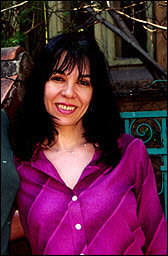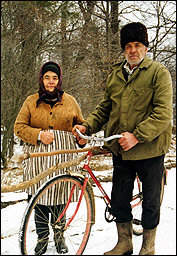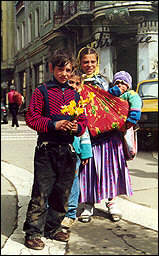 PEOPLE PEOPLE |
Romania is inhabited by 23 million people. Bucharest, Brasov, Constanza, Iasi and Timisoara are the cities with the highest population.
 Romanians Romanians |

Due to its past history, Romanians are a curious mixture of people. They take a great pride in their Roman heritage, claiming they are Latin people in a Slavic sea. In fact, Mediterranean and Latin traces can be found in many Romanians softened by the cross breading with their neighbors. Relatively large portions of the population are Saxon, Hungarians and Gypsies.
 Hungarians Hungarians |
Romania has been for past centuries in constant fight with the Hungarians, who until recently possessed the region of Transylvania. Many of them established themselves there, and still many towns, notably Cluj-Napoca and Tirgu Mures have majority of Hungarians. This ethnic group has kept its traditions, language and religion (Roman Catholics). Even today relations between Hungarian and Romanians are not totally healed, however lately there seems to be more tolerance for this ethnic group.
 Saxons Saxons |
 |
In the XII century Geza II, King of Hungary, brought Saxons from Germany to defend the mountain passes in the Carpathian range from invaders. This group populated large areas in the Carpathian region and in Transylvania. Some of the cities they constructed: Brasov, Sibiu or Sighisoara, became real emporia of culture and trade. They became so powerful that they even got involved in war with the Wallachians (Romanians). Their numbers soared up to 800,000 at the beginning of the century, but during WW II most of them left the country or were deported. Today they are a minority since after the fall of the Berlin Wall many have settled in Germany.
 Gypsies Gypsies |

Despite the large number of Romanian Gypsies that emigrated after Romania opened its doors following Ceausescu's defeat, the population or Gypsies is still considerably large. For one, it has one of the highest fertility and birth rates in the country. Despite the poetic aura than surrounds them for Westerners, Gipsies are not very much liked in Romania, reactions verging with xenophobia. One of the reasons behind this is their totally free way of life, not subject to any law or order imposed by any authority that is not theirs. Like anywhere else in the world, Gypsies are blamed for every possible evil in the country. However, a number of them have made it, such as the present major of Bucharest. Still, plenty of boys of that ethnic group and under-aged girls carrying small children can be seen begging in the streets of every Romanian city.
This variety of races and ethnic groups have justly enriched the Romanians who are a very hospitable people used to welcome foreigners in their land. |

